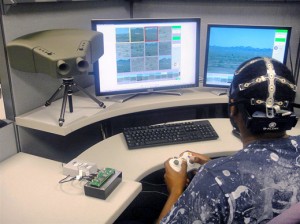Health care via mobile technology is still in its infancy. Of 75 trials in which patients used mobile tech, such as text messaging and downloadable apps, to manage a disease or adopt healthier behaviors, only three showed reliable signs of success, according to a systematic survey. In an accompanying survey of medical personnel who used smart phones and other devices, to help deliver care, the same team found more success: 11 of 42 trials had positive, reliable results. Continue reading App’d to Fail: Mobile Health Treatments Fail First Full Checkup
Tag Archives: Technology
Sentry System Combines a Human Brain with Computer Vision
 Sentry duty is a tough assignment. Most of the time there’s nothing to see, and when a threat does pop up, it can be hard to spot. In some military studies, humans are shown to detect only 47 percent of visible dangers.
Sentry duty is a tough assignment. Most of the time there’s nothing to see, and when a threat does pop up, it can be hard to spot. In some military studies, humans are shown to detect only 47 percent of visible dangers.
A project run by the Defense Advanced Research Projects Agency (DARPA) suggests that combining the abilities of human sentries with those of machine-vision systems could be a better way to identify danger. It also uses electroencephalography to identify spikes in brain activity that can correspond to subconscious recognition of an object. Continue reading Sentry System Combines a Human Brain with Computer Vision
Machine Vision Sees Into Chickens’ Futures
 A jump to the left and a step to the right are signs of healthy activity, as chicken farmers who stroll among their flocks already know. Now a team led by robotics engineer Stephen Roberts at the University of Oxford has found that patterns in the collective motion of a flock of chickens can help farmers predict disease weeks before onset. Call it a chicken time warp.
A jump to the left and a step to the right are signs of healthy activity, as chicken farmers who stroll among their flocks already know. Now a team led by robotics engineer Stephen Roberts at the University of Oxford has found that patterns in the collective motion of a flock of chickens can help farmers predict disease weeks before onset. Call it a chicken time warp.
Roberts and animal-welfare researchers at Oxford first tested their pattern-detection system by asking it to warn farmers before a flock got “peckish.” That’s not a euphemism for “hungry.” Well-fed hens, it turns out, sometimes take out their worm-hunting instincts on one another. The system, which consisted of cameras recording a flock, followed by computer analysis of the footage, beat human experts at flagging the at-risk flocks before the madness took its toll [“Computer System Counters Hen Horrors,” September 2010].
Read the rest of this news story in IEEE Spectrum [html] [pdf]
Biometric Bracelet Lets a Medical Device Recognize its Wearer
A device that measures someone’s unique response to a weak electric signal could let medical devices such as blood-pressure cuffs automatically identify the wearer and send measurements straight to his or her electronic medical record.
For now, nurses, patients, and doctors juggle the job of keeping patients’ identities straight. But computer scientist Cory Cornelius at Dartmouth College, in New Hampshire, has developed a wristwatch-like device that measures a person’s “bioimpedance” to identify him or her to medical monitoring devices.
Cornelius and colleagues presented a prototype sensor at the Usenix Advanced Computing System Association workshop in Bellevue, Washington, on Monday. Individual impedance varies because each person’s wrist, for example, is a unique jumble of bone, flesh, and blood vessels. Continue reading Biometric Bracelet Lets a Medical Device Recognize its Wearer